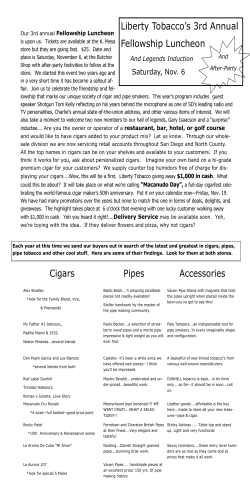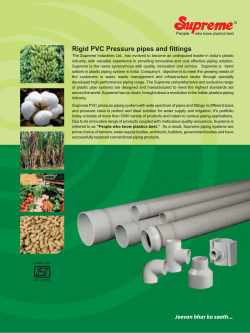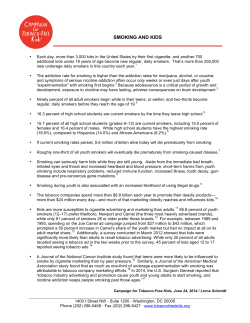
Document 106737
THE BASIC STEPS OF PROPERLY PACKING A PIPE Step 1: Gravity feed tobacco into the bowl of the pipe. Gently level off the excess with the top of the bowl. Press the tobacco down gently about 2/3 from the top of the bowl. Making sure that this layer is even and loosely packed, not firmly packed. Step 2: Again, gravity feed tobacco into the bowl, gently level off the excess with the top of the pipe. Press slightly harder, this time until the tobacco is about 1/3 from the top. Keep in mind that a larger bowl will require more layers as you work your way to the top of the bowl. These layers will be slightly more compressed than the first layer. Note: Once this top layer is lit with the false light it will expand and loosen. Now, use your tamper to even up this top part, relight and smoke down through the layers to the bottom of the bowl. Again smoke s-l-o-w-l-y. Don’t let your new pipe get too hot. IMPORTANT NOTE: Don’t knock the ashes out of the first load of your pipe. Instead, just fluff the loose ash out gently. If there is unburned tobacco mixed in with the ashes, you are not smoking far enough down. Make sure that you have only a grey ash residue in the bottom of the pipe. You should always cake the heel first; the top will gradually cake itself after a number of smokes. As your carbon cake builds on the inside of the pipe, the cake may be uneven, or thicker at the top than at the bottom. Should this occur, use a conical shaped reamer to shape the cake thinner at the top and slightly thicker at the heel. We recommend that you bring your pipe to your Tinder Box after about a week of smoking. Your Tinder Box tobacconist will be happy to inspect the cake, and if necessary, shape the cake for you free of charge. PIPE CARE NOTE: It is important to use fresh tobacco at all times; dry tobacco will “crunch” down and produce a hot smoke. When cleaning a new pipe, use pipe cleaners frequently but cautiously. Running them all the way down into the bowl may peel away the new cake before it has a chance to set. Rest your pipe at least a full day after smoking it. Give the accumulated oil and moisture a chance to dry out. Be sure to set the pipe at the proper drainage angle, with the bowl lower than the stem. Your reward will be a dry pipe that smokes cooler and sweeter. Rotate your pipes. Owning and smoking a number of different shapes and styles of pipes will put more variety and interest in your pipe smoking, and will give each pipe a chance to dry out. LIGHTING YOUR PIPE RELAXING WITH A PIPE Step 3: Once more gravity feed the tobacco just enough to top off the bowl. Press firmly. The tobacco should be slightly springy and level with the top of the pipe bowl. When lighting, puff with long, slow puffs. Move the match or lighter slowly around the outside edge of the tobacco. Puff as many times as necessary to completely light the top surface of the tobacco. This is called the “false” or “charring” light. This will assure an even burning load. Next take the pipe out of your mouth, and tamp the ashes gently; pressing them down on the unburned portion of tobacco. Now, relight and puff rhythmically. Part of the joy of smoking a pipe is the relaxation it provides. Smoke your pipe slowly. Take time to enjoy the full flavor of the fine tobacco. No need to inhale; the enjoyment comes from the taste. Have a good supply of wooden matches (or butane lighter) and pipe cleaners nearby so you won't have to keep getting up from your chair. Some of the most famous people in history have been pipe smokers: fictional characters, world leaders, military leaders, as well as leaders in business, sports and entertainment. A good pipe creates contentment and harmony within yourself. It’s a way of relaxing, thinking and enjoying the finer pleasures of life. TONGUE BITE: (The most common pipe smoking problem.) Tongue bite, or an irritation of the tongue, is caused by one or more of the following reasons: 1. Improper cake (or no cake) in the heel. This causes a BRIAR pipe to smoke hot. 2. A “drug store” quality pipe fitted with a filter system which traps bitter fluids in the shank of your pipe. 3. Tobacco too tightly packed in the heel. This leaves no air pockets for good combustion. 4. Smoking low quality commercially packaged tobaccos containing preservatives and other artificial ingredients. 5. Not tamping evenly or often enough. 6. Smoking or puffing your pipe too fast. Cigarette smokers often have this habit when switching to a pipe. THE TINDER BOX PIPES Tinder Box is proud to provide you with a complete range of pipes in all shapes, finishes and prices. We handle export production of several European pipe makers and are thus able to offer you everything from magnificent free form and standard shape pipes to reasonably priced machine mades. Whatever priced pipe you decide to purchase, you will get more satisfaction by trading at Tinder Box. Tinder Box tobacconists are specialists, offering a full range of products and services for the pipe smoker. They can offer suggestions on pipes, tobacco and smoking techniques. Just ask, they will be delighted to help. THE BRIAR PIPE ITS HISTORY, MANUFACTURE AND ENJOYMENT ON THE NATURE OF BRIAR…. THE BRIAR PIPE A BRIAR Pipe begins as a “Burl” (or growth) on the root system of the White Heath Tree, a squat, hearty, shrub-like plant which grows primarily in the dry, arid, rocky wastelands around the Mediterranean Sea. Of all woods, the BRIAR Burl is unique for making pipes; it is tough, porous and nearly impervious to heat. Burls for fine quality pipes can often be 50 to 100 years old when harvested for pipe making. ….AND BRIAR PIPES PREPARED FOR YOUR ENJOYMENT FROM OVER 75 YEARS OF EXPERIENCE AND STUDY ON THE NATURE OF PIPES AND PIPE SMOKING. Once harvested, the BRIAR burls are cut by skilled craftsmen using large, circular saws to remove the soft and cracked portions, leaving only close-grained, extremely hard BRIAR wood. This remaining BRIAR is then rough-cut into small blocks, called “ebauchons”, in sizes and shapes suitable for fashioning into standard shape pipes. Some particularly fine grained BRIAR is left uncut in larger pieces called “plateau” which is used for larger free form pipes and well grained standard shapes. When harvested, BRIAR contains considerable moisture, sap and resin. The ebauchons and plateau pieces are boiled in water for several hours to remove much of the sap and resin. This is followed by long periods of drying (up to 5 years) so that all traces of moisture are removed from the wood. This careful “curing and aging” process is of the utmost importance in bringing out the finest smoking qualities of a briar pipe. It allows the pipe “to breathe,” to absorb moisture and oil from the tobacco, assuring a cool, dry smoke. HOW TO SELECT A NEW PIPE The material in this book is the property of Tinder Box International and is protected by claim of copyright. It is not to be reproduced in whole or in part without express written permission of Tinder Box International. Copyright© 2003 Selecting a new pipe is an important factor in the overall enjoyment of pipe smoking. Because of the fact that BRIAR is a natural material and grows under very extreme conditions, only a small percentage of all the pipes produced will have uniformly fine grain patterns and perfection of finish upon which a manufacturer or individual will stamp their name. These exceptional and rare pieces will go through an extended curing or drying process and then the blocks will be graded to make the finest pipes possible. These hand made pipes break down into two main types: Free Form and Standard Shape. Since both of these types are made by hand, weight and balance, draft hole drilling and the flush fit of the mouthpiece are all impeccably crafted by skilled artisans. Free form pipes are carved to accentuate the grain and the grain will dictate the shape. These pipes are one of a kind and are known for their unique design. There are many standard shapes, dozens in fact, and once the craftsman has "read" the grain of the unfinished Briar blocks, the pipe will be carved into one of the standard shapes which best reveals these grain patterns. A smooth finish is always most desirable in these pieces, but sometimes there will be little imperfections that will dictate a sandblast or rusticated finish. The smoking quality remains the same. Considering the number of steps taken and the amount of care given to each of these unique and rare pieces, it is understandable that they will demand top dollar. Serious pipe collectors take great pride in owning and smoking these fine briars. The majority of pipes you will find at your favorite Tinder Box will be machine made or mass produced. These will be very affordable and are the pipes that are sought out by both beginners and established pipe smokers. Often these pipes will have imperfections in the surface and fillers will be used to conceal these defects. Keep in mind that these imperfections have nothing to do with smoking quality. These pipes often are not as well seasoned or cured and they do not have all the attention to detail that the high grades possess, but because of their reasonable price and good looks, they are most appealing. Most every manufacturer has pipes in this category and you will want to evaluate each piece for aesthetic beauty, weight, how the pipe feels in hand and the bowl capacity when making your final decision. Your Tinder Box tobacconist is a knowledgeable, skilled professional. He or she can answer any questions you may have about BRIAR pipes and can provide invaluable assistance in the selection process. SMOKING YOUR PIPE (this is the best part!) Your greatest smoking pleasure will come from learning and practicing the basic techniques employed by pipe experts. A cool, dry, flavorful smoke time after time will be your reward. Once you know the secrets of loading, lighting and tamping your pipe, you will enjoy the full richness and flavor of your tobacco. Your pipe will stay lit longer and give you full smoking satisfaction. HOW TO BREAK IN YOUR NEW PIPE “Breaking in” your new pipe simply means developing a thin layer of carbon or “cake” on the inside wall and in the heel (bottom) of the bowl. The carbon cake acts like a grate in a fireplace to improve the draft and ensure complete combustion. It also serves as a barrier between the burning tobacco and the bare wood. Many pipes are pre-carbonized to assist you in the break-in process. There are several methods of breaking in a new pipe. Tinder Box recommends beginning with a full bowl of tobacco. The most important thing is to smoke the tobacco all the way to the bottom! SMOKE SLOWLY. Tamp and relight as often as necessary; do not be afraid of using too many matches. If your pipe gets too hot, let it rest awhile; then tamp the dead ashes and relight. You can test if the pipe is too hot by placing it against your cheek. If it is uncomfortably hot, set is aside and allow the pipe to cool. PACKING YOUR PIPE The packing method we recommend is LOOSE AT THE BOTTOM AND MORE FIRMLY AS YOU WORK YOUR WAY UP TO THE TOP OF THE BOWL. Before you start this process, rub your tobacco between your fingers and get a feel for its moisture content and texture and remove any hard bits that will only interrupt the burning. Aromatic or flavored tobaccos will always have a higher moisture content than non aromatics, burleys or Virginias, and therefore should be packed even looser at the bottom to provide for proper air space between layers. The number of layers you create inside the chamber will vary depending on bowl size. Once packed, the tobacco on top should feel springy and will expand once it is lit. You will use your tamper to gently push one layer into the next unlit layer to keep the combustion process going and allow for an even burn throughout. The packing process is absolutely the MOST IMPORTANT aspect of pipe smoking and with a little practice you can become an expert. If problems persist, ask your Tinder Box tobacconist for a demonstration.
© Copyright 2024




















